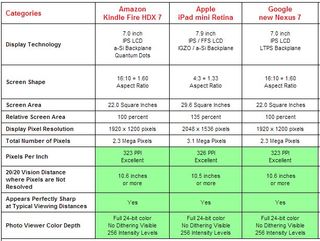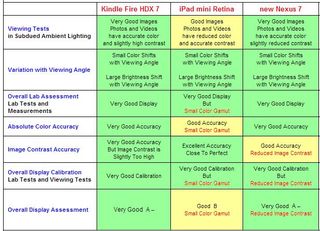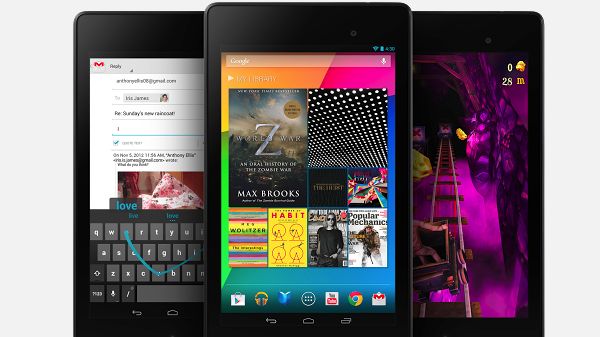Why you can trust TechRadar
The display comparison between the iPad Mini 2 (you know, the one with Retina display), the Google Nexus (2013) and the 7-inch Amazon Kindle Fire HDX has taken a massive step forward, simply because things have become so much more powerful.
For instance, each display has a near identical sharpness, with the iPad Mini 3ppi crisper over its 7-inch rivals. The iPad Mini 2's 7.9 inch screen is rocking a resolution of 2048 x 1536 compared to the standard 1920 x 1200 in the rivals.
Think what you will about the move in smartphones to see the difference in sharpness, but there's no doubt that each of the three tablets on test here all display superb crispness in screen quality. Compare that to the iPad Mini of 2012, and I'm glad that Apple has finally moved its smaller tablet into the future.
There's an obvious difference between the iPad Mini 2 and the others - namely the screen ratio. Apple's decided that movie watching can be happily done with black bars above and below the screen, as its 4:3 ratio is better for apps and browsing the web. Weirdly the problem with the iPhone 5S and 5C isn't the same, as they've slipped to the 16:9 form that's the same as its rivals.
However, while the other two are more suited to watching movies, there's no doubt that it's a more pleasant experience to use the iPad Mini 2 for browsing the web and flicking through games. The packaging shapes the iPad in a way that makes it actually easy enough to hold in one hand with a full grip - although there's a chance that using the original Mini for a year has stretched the palm.

That's not to say Google and Amazon's offerings aren't great for web browsing too, but going from the Mini 2 to one of these wasn't a pleasurable experience.
The only problem, if I was to identify one, is that Apple hasn't made the best screen on the market, according to DisplayMate. Ray Soneira of the same laboratory testing facility has run the three displays through a variety of tests, and while the Mini 2 performs fairly well in most scenarios, it's often bested by the competition.
For instance, that while all three have a really good level of sharpness at distance and differing viewing angles, and critically performed well when being calibrated, in many cases the iPad Mini 2 came up short. For instance, the colour reproduction wasn't as good compared to the other two, and the contrast wasn't as accurate.
The iPad Mini 2 definitely errs on the more 'natural' when it comes to colour reproduction, according to DisplayMate's findings, and in my own side by side tests I noted the same thing. The iPad Mini 2 takes things too far at times, where the others show a clear and rich picture, especially when viewing photos.
This leads to lower colour accuracy too, where the others managed it quite happily; again, natural options are too the fore here. I noticed that the Amazon Kindle Fire HDX has the best screen for movies and photos, which is down to two things: dynamic contrast and using quantum dot technology.

The former you'll be able to see easily - lower the brightness on the screen when looking at a photo, and the decrease won't be uniform. This might sound bad but what it does is keep the darker scenes well lit so you can still make out all portions of the screen without losing the overall visibility. For a tablet that some might say is only there to allow users to buy more things, the technology is very effective.
But what of Quantum Dots? Here's what DisplayMate had to say on the subject: "Quantum Dots are almost magical because they use Quantum Physics to produce highly saturated primary colors for LCDs that are similar to those produced by OLED displays.
"They not only significantly increase the size of the Color Gamut by 40-50 percent but also improve the power efficiency by an additional 15-20 percent. Instead of using White LEDs (which have yellow phosphors) that produce a broad light spectrum that makes it hard to efficiently produce saturated colors, Quantum Dots directly convert the light from Blue LEDs into highly saturated primary colors for LCDs."
You can head over to the DisplayMate report to see the full findings of the tablet test, but the results were that while the Amazon and Google tablets were matched in terms of performance, the iPad Mini 2 had less accurate colour reproduction, and lower peak brightness while still drawing the most power - it was also the most reflective.
That said I do like the natural reproduction of the iPad Mini 2 - the other two did err one the 'impressive' side when it comes to display type, which can grate slightly at times but wow most others.
Verdict
I'm really splitting hairs here - all three tablets have an incredible screen, which is a big step forward over last year. Apple might struggle with things like colour reproduction, and colour accuracy is a worry, but it's not a bad effort, despite sitting well in third place.
The other two tablets just have great screens and offer brilliant value for money as a result - there's nothing to choose between them in my eyes, but I do prefer the dynamic range of the Kindle Fire HDX in day to day tests, although I can't really get on board with the UI. Overall the Google Nexus 7 is my pick - but I urge you to try all three and see which suits your tastes most.












